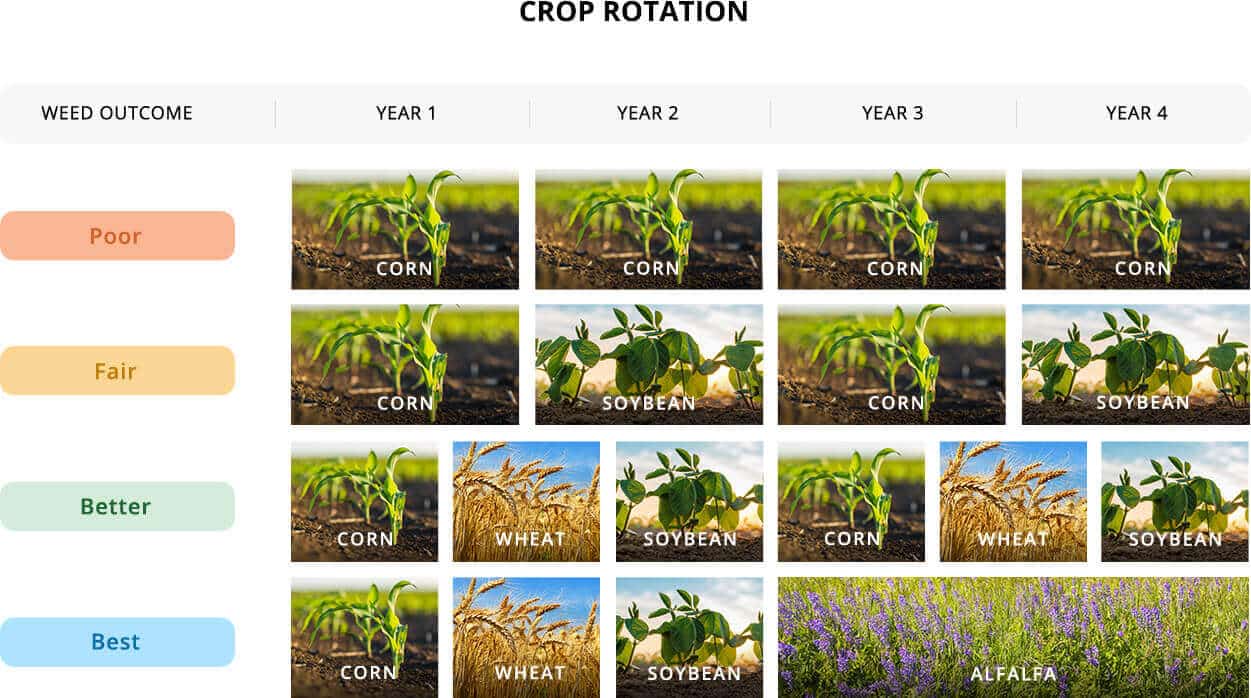Crop Rotations
How Does Crop Rotation Suppress Weeds?
Crop rotation is the cultural practice of planting different crop species across years. This practice is known to suppress weeds, diseases, insects, and nematodes. But how much does crop rotation suppress weeds? One long-term study found that crop rotation itself only explained a minimal amount of the difference in weed density while most of the changes in weed density were driven by weed management strategy (i.e. tillage or herbicides). Although the overall effect on weed density can be minimal, crop rotation has a large impact on diversity of weed species. Differing crops offer differing levels of competition for weeds. For example, corn is generally planted earlier, grows taller, and is harvested earlier than soybeans so it is more competitive with weeds.
Diversity is Key
The value of crop rotation lies in the fact that it creates the opportunity to use diverse weed management strategies. Differences between cropping systems that impact weed diversity include:
- Planting timing
- Row spacing
- Crop competition
- Fertility management options
- Weed management options
- Herbicides
- Tillage or cultivation
- Potential to include a cover crop
- Potential for use of harvest weed seed control
Increase the Number of Crops and Length of Rotation
With monocultures such as continuous corn, weed species that thrive under the conditions created for optimal monoculture crop growth become the dominant weed species in the fields. These weeds are often problematic because they are difficult to control with the tools available. Over time, populations of these weed species build up, sometimes to disastrous levels. Diversifying crop rotations, which leads to diverse weed management tactics, allows for more weed diversity and keeps weed populations under control.
As the diversity of the rotation increases, weed management benefits increase (Figure 1).

Moving from a monoculture (e.g., continuous corn) to alternating summer annual crops (e.g., corn-soybean rotation) is the first step. But thinking about crop diversity across a longer rotation will have a greater impact on weed populations. Adding in a small grain during the winter, if possible, will shift planting times and disrupt weed germination. If the rotation also includes a multi-year or forage crop, that will lead to greater changes than rotating summer annual crops alone. Also, perennial forage systems are very competitive against germinating weeds because of the thick crop canopy that allows for year-long competition against weeds.
Conclusion
Crop rotation in itself is a cultural tactic for suppressing weeds but even more so allows for alternative weed management strategies to create a diverse environment where weeds won’t be able to thrive.
Resources
- Doucet C, Weaver SE, Hamill AS, Zhang J (1999) Separating the effects of crop rotation from weed management on weed density and diversity. Weed Science 47:729-735.
- Mohler, Charles L. The Role of Crop Rotation in Weed Management. Sustainable Agriculture Research and Education.
https://www.sare.org/Learning-Center/Books/Crop-Rotation-on-Organic-Farms/Text-Version/Physical-and-Biological-Processes-In-Crop-Production/The-Role-of-Crop-Rotation-in-Weed-Management - Liebman M and Dyck E (1993) Crop rotation and intercropping strategies for weed management. Ecological Applications 3:92-122.
Authors
- Kara Pittman (Virginia Tech)
- Michael Flessner (Virginia Tech)